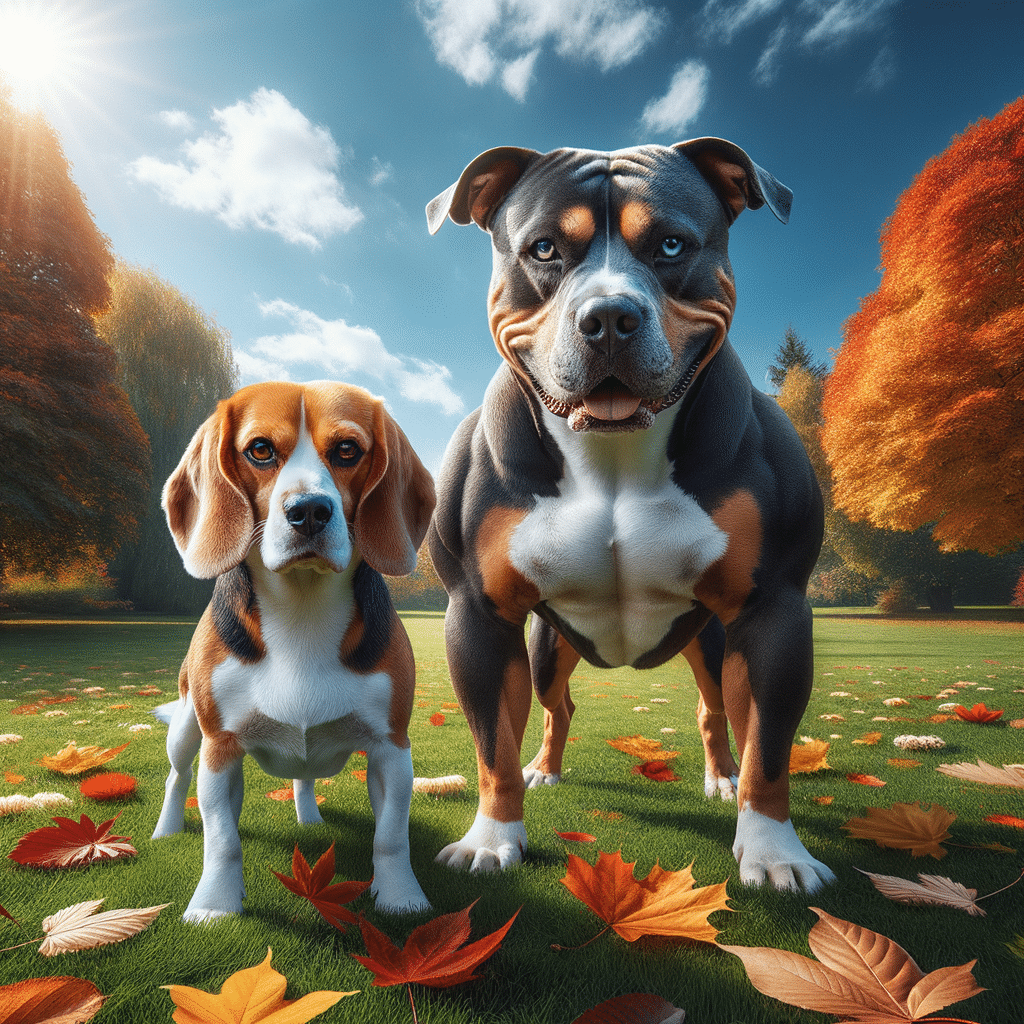Potential pet owners often compare dog breeds to find the ideal match for their lifestyle when selecting a dog. Beagles and Australian cattle dogs are popular choices with unique traits and histories.
In This Article
Beagles, known for their friendly nature and compact size, are a breed well-suited for families and first-time dog owners. In contrast, the Australian cattle dog, renowned for its intelligence and high energy levels, requires an experienced hand and thrives in an active environment.
While these breeds may share their status as dogs, their differences are pronounced, mirroring their distinct breed origins and purposes. Beagles have a strong sense of smell and were initially bred to hunt small game, making them persistent and tireless workers with amiable dispositions.
Australian cattle dogs, also known as the blue heeler, were developed in Australia as herding dogs to guide cattle across expansive terrains. This is why they possess a natural inclination for hard work and a protective demeanor. In terms of physicality, the Beagle typically displays a broader spectrum of colors and maintains a smaller stature than the Australian cattle dog’s sturdily built and often blue or red-speckled coat.
Understanding the specific needs of both beagles and Australian cattle dogs is crucial; they require different approaches to care, training, and socialization to ensure healthy and balanced lives. Beagles often require ample exercise to manage their weight and satisfy their curiosity, while Australian cattle dogs need consistent mental stimulation and physical activity to match their energy levels. Both breeds can make loyal and delightful companions when properly cared for, albeit in varying household environments.
Highlights
- Choosing between a beagle and an Australian cattle dog depends greatly on the owner’s experience level and lifestyle.
- Beagles and Australian cattle dogs have distinctive breed-specific characteristics and attitudes.
- Understanding the unique care requirements and proper training is essential for either dog breed.
Breed Origins and History
The beagle and the Australian cattle dog each have a rich history. They were bred in different parts of the world for distinct purposes. Their unique histories reflect the development of two popular dog breeds adapted to specialized roles in human society.
Origins of the Beagle
The beagle, a breed group with its earliest roots in England, can trace its origin back to the Roman occupation. The Romans may have brought small hound ancestors of the Beagle, which were likely bred with local hounds. Over time, the English beagle emerged: a breed optimized for hunting due to its excellent sense of smell and tracking ability. It is suggested that by the fifth century, Greece saw similar hounds used for hunting or dog sports, which could point to an even more ancient lineage.
History of the Australian Cattle Dog
In contrast, the Australian cattle dog originated in Australia during the 19th century. This breed, developed from a mix that included the Dingo, Collie, and Dalmatian, was bred to withstand the Australian continent’s harsh conditions and vast expanses. Known regionally as the Queensland Heeler, or more commonly the blue heeler or red heeler, depending on its coloring, the Australian cattle dog was designed to herd cattle over long distances, a testament to its endurance and work-driven temperament.
Physical Characteristics and Temperament
Prospective owners should consider the differences in physical attributes and temperament when choosing between a beagle and an Australian cattle dog. Both breeds possess unique traits that cater to varied lifestyles and household needs.
Comparing Size and Appearance
Beagles generally come in two size variants:
- Under 13 inches at the shoulder
- Between 13 and 15 inches
As a purebred dog, beagles usually weigh between 20 and 30 pounds. They are recognized for their tri-color coats, most commonly black, white, and brown. They have long, hound-type ears and possess a sturdy build despite their smaller size.
On the other hand, Australian cattle dogs are more uniform in size. They typically stand between 17 and 20 inches at the shoulder and weigh 35 to 50 pounds. Their coats are often blue or red-spread, and they have upright ears. Due to their heritage as a herding breed, Australian Cattle Dogs have a muscular and agile appearance.
Dog Behavior and Personality Traits
Beagles are widely known for their friendly and curious nature and energetic demeanor. They tend to be excellent with children, making them suitable for family settings. Beagles are loyal and loving but may follow their noses, leading to distractions if not properly trained.
In contrast, Australian cattle dogs are exceedingly intelligent and energetic and bred to herd animals over long distances. They require significant physical and mental stimulation to avoid developing destructive behaviors. Though less immediately friendly with strangers, with proper socialization, they can become quite affectionate with their families. Their herding instincts make them vigilant watchdogs, always alert for environmental changes.
The beagle and Australian cattle dog are intelligent breeds, which can lead to them being independent and sometimes stubborn; consistent training is vital for both. Their energy levels and affectionate dispositions make them rewarding companions for active households that can dedicate time to their exercise and care.
Care and Living Environment
When considering the care needs of the Beagle and the Australian cattle dog, owners should understand the significant exercise requirements and grooming needs associated with each breed. Proper attention to these will ensure a healthy, happy life for the dog, regardless of whether it lives in an apartment or a house with a yard.
Exercise and Activity Needs
Beagles have a high energy level and require regular exercise to prevent obesity. They enjoy long walks and play sessions. Since they were bred for hunting, beagles have an innate desire to explore and follow scents, which must be satisfied through active play and outdoor activities.
Daily exercise recommendations include:
- Minimum 30 minutes of brisk walking or play
- Engaging in scent-related games is beneficial
Australian cattle dogs are known for their herding heritage. They display high levels of energy and intelligence, which translate into substantial exercise needs. They thrive with a job to do and require physical and mental stimulation to avoid developing behaviors like digging or chewing out of boredom.
Daily exercise recommendations include:
- Minimum 1 hour of intense activity, such as running, agility, or herding exercises
- Regular engagement in training or problem-solving activities
Grooming, Dog Nutrition, and Health Management
Beagles: Beagles have short coats that shed moderately throughout the year. They require routine grooming, including regular brushing to minimize shedding and bathing as necessary. Health-wise, they can be prone to obesity, epilepsy, and allergies, so a balanced diet and weight management are essential.
The Australian cattle dog has a weather-resistant coat that sheds seasonally. During shedding seasons, more frequent brushing is advised to control the amount of hair and distribute natural skin oils. They are generally robust but can suffer from hereditary health issues like hip dysplasia or deafness. Regular vet check-ups help in early diagnosis and management.
Both breeds can adapt to apartment living if their exercise and activity needs are met. However, due to their high energy and tendency toward separation anxiety, your energetic dog will benefit from ample space to roam and play, whether in a securely fenced yard or through frequent outings.
Neither breed is hypoallergenic, requiring owners to invest time and effort into their care routine. They also both fare well in most climates, but during extreme cold or warm weather, protective measures and monitoring are essential to maintain their comfort and health.
Training and Socialization
Let’s focus on the differences in training approaches and social characteristics between beagles and Australian cattle dogs, two breeds with varied activity levels and social requirements.
Training and Intelligence
Beagles are energetic dogs known to be intelligent and curious, traits that can be leveraged during training sessions. They typically rank as easy to train due to their eagerness to please and responsive nature. However, their independent streak may require a consistent and patient approach.
- Trainability: Moderate to High
- Intelligence: Not the most intelligent breed, yet still clever
- Activity requirement: 90 minutes of exercise per day is optimal
On the other hand, Australian cattle dogs are among the smartest dog breeds, meaning they are highly intelligent and easy to train. Known for their obedient and responsive behavior, they thrive on having a job or activity due to their herding background.
- Trainability: High
- Intelligence: Often listed among the smartest breeds
- Activity requirement: 1-2 hours of vigorous exercise per day
Social Behavior and Adaptability
Regarding social behavior, beagles are generally very friendly and social animals. They make excellent family dogs and are usually good with children and other pets. They often seek companionship after adoption.
- Group: Hound
- Kid-friendly: Yes
- Pet-friendly: Yes
- Tendency to bark/howl: Moderate to High
Australian cattle dogs display progressive retinal atrophy less frequently than beagles, which is worth considering for future health management. When it comes to popularity, both breeds are well-regarded. Beagles are often more popular in urban settings, while the blue heeler dog is prized in rural areas for its herding prowess.
- Group: Herding
- Kid-friendly: Yes, with proper socialization
- Pet-friendly: Can be, with early socialization
- Tendency to bark: Lower than beagles; may become protective when required
If under-stimulated, both breeds can show unwanted behaviors like chewing, digging, and barking. Training and adequate exercise are vital in minimizing these behaviors. Australian cattle dogs, in particular, may tend toward watchful or guarding behavior and can be more independent and protective, making them excellent candidates for watchdog roles.
Frequently Asked Questions
When choosing between a beagle and an Australian cattle dog, you might have questions about temperament, size, breed characteristics, friendliness, resilience, and suitability for first-time owners. Keep reading to compare dog breeds and answer these questions:
What are the temperamental differences between beagles and cattle dogs?
Beagles are known for their friendly disposition towards humans and other dogs, making them a popular choice for families. Australian cattle dogs, on the other hand, are more work-oriented and may exhibit strong protective instincts due to their herding background.
How do beagles and cattle dogs compare in size?
Most beagles stand about 13-16 inches at the shoulder and weigh around 20-30 pounds, so they are considered midsize canines. Australian cattle dogs are slightly taller, generally between 17-20 inches tall and weighing 30-50 pounds.
What are the distinctive characteristics of a cattle dog’s breed lineage?
Australian cattle dogs have a notable lineage that includes dingo ancestry, which contributes to their high intelligence, agility, and endurance. Additionally, their breed history as herding dogs makes them vigilant and capable of independent decision-making.
How does the friendliness of beagles compare to other dog breeds?
Beagles are widely recognized for their gentle and amiable nature. They are often cited as one of the most child-friendly breeds, demonstrating a great capacity for patience and playfulness, which makes them stand out among other breeds in terms of friendliness.
Which breed is considered the most resilient among cattle dogs?
The Australian cattle dog is renowned for its resilience. These dogs display significant toughness and stamina, a trait developed to help them handle the challenging conditions of herding livestock across diverse Australian terrains.
Is a cattle dog a suitable choice for first-time dog owners?
Australian cattle dogs are generally not recommended for first-time dog owners. Their strong will, high energy levels, and need for a job or activity make them better suited to experienced owners who can provide firm training and ample mental stimulation.






